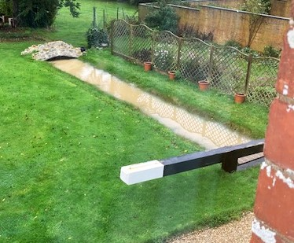Torrential rain
Visit by Somerset Rivers Authority followed by torrential rain.

On 21st December some of the staff of Somerset Rivers Authority accompanied by Kate Towers and Phil Stone of the Reimagining the Levels team visited the Trust land to see for themselves the progress that has been made with the planting.(see picture on home page) It’s important at this stage to assess what impact the transformation of the land has had. Although quantifying the reduction of water flow is not possible we can say that water flow from the field has been reduced. The picture above shows an attenuation pond we have constructed at home in the shape of a lock, a sort of water feature that is dry except in exceptional circumstances. The water from the Trust field flows in two ways from the crest of the land, north to Sedgemoor and southeast to the village. On its way to the village it passes our house and fills the “lock” Last year there was noticeably much less water flowing off of the Trust land, which was just as well because the cultivated fields in-between the Trust land and ours shed a torrent of water into the lock. The picture shows the “lock” at the fullest it has ever been. . This water was held back for a couple of days and then gradually drained away. The water drains into a grove of very large conifers and onto an area where 30-40 new trees have been planted. Before the planting was done the land was compacted and had standing water in the winter for days or weeks, so this year one would be forgiven for expecting the land to be flooded extensively for a long time. However I was pleasantly surprised at the speed at which the water was absorbed by the ground. It is remarkable to compare how regularly cultivated land deals with water compared to land that has been planted with trees and the vegetation between the trees cut once a year in late summer. Both the physical act of planting trees and the roots of the growing trees open up the ground. No cultivation means that, in the summer, cracks open in the soil, quite deep in places and also huge numbers of ants dig networks of tunnels and push the spoil into hills above ground. These activities turn the area into a sponge rather than an impermeable membrane. So the planting of trees works to increase water absorption and as time passes and the trees grow even more water will be absorbed. This has become essential as rainfall will continue to increase and become heavier in winter. So Water Street and the School have not flooded during this year’s monsoon and I am certain our efforts have been partly responsible. Looking at the the flood warnings in place for the country this morning (4 Jan) and with more rain expected it is hard to be optimistic about controlling flooding (some houses in Worcester have now flooded fives years consecutively when they were originally told it was a 1 in 100 year event). Somerset’s tree strategy must succeed if we are to have any chance of controlling flooding across the County..I hope I have convinced you that planting trees will provide as much of an answer as Somerset can manage. It’s also very cost effective visually attractive and supports biodiversity and carbon capture. What’s not to like!!


